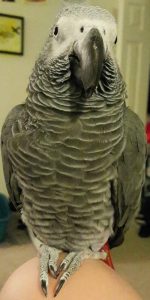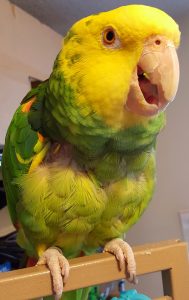Are you new to sharing your home with exotic companion birds? Don’t worry – Bird Cages 4 Less has your back. Welcome to our “How To” posts, a recurring series of articles dedicating to helping you be the best parront on the block.
It’s easy to get caught up in the whirlwind of buying or adopting your first parrot. There’s just so much to do – from meeting the perfect bird, to finding the perfect cage, to bringing it all home – it can be exhausting. Before your parrot is ready to make his debut in your home, however, it’s a great idea to have his cage already set up for him. Not only will it ease the stress of having traveled to his new home, but you won’t have to leave him in his carrier as you put the cage together and add in all his perches. Of course, you’ve already taken a look at our March Cage Series to help you select the perfect cage for your new pal, and you followed us through the April Perch Series to square you away there, too. So, let’s talk about cage placement!
If you aren’t familiar with your new parrot’s personality and demeanor, you’ll want to pick an area of the home where the family spends a good amount of time, but there isn’t TOO much activity. If you have just adults in the home, or older children, this room may be the den or living room. It’s likely that you’re out of the home at work or school during the day, so your bird will have quiet time to relax, but the evenings will be busy with people in the home. Most companion parrots are kept in the living room for this reason. For families with young children who are perhaps home for the majority of the day, the personality of the parrot will be a big deciding factor on where he should be kept. A sociable bird who loves to chatter and sing may enjoy the constant action of a toddler in the living room,
while a more reserved parrot may feel frightened or on-edge with the same level of activity. A shy parrot may prefer to be kept in the dining room, or a more secluded room, and brought out on a stand when the kids aren’t playing.
You’ll wan t to avoid putting the bird cage directly in front of a window so your bird won’t be spooked by movement outside and possibly injure himself inside the cage. Birds tend to enjoy a peek outside to watch the clouds and cars drive by, but may also become scared if a car honks, a bird of prey circles by in the sky, or a dog barks nearby. Having the cage off to the side of the window allows the cage to receive natural sunlight and your bird to catch a glimpse of the outside, wi
t to avoid putting the bird cage directly in front of a window so your bird won’t be spooked by movement outside and possibly injure himself inside the cage. Birds tend to enjoy a peek outside to watch the clouds and cars drive by, but may also become scared if a car honks, a bird of prey circles by in the sky, or a dog barks nearby. Having the cage off to the side of the window allows the cage to receive natural sunlight and your bird to catch a glimpse of the outside, wi
thout the constant visual stimulation causing stress. Another reason to keep the bird cage away from the front of a window is to keep your bird free from drafts, which may cause illness.
Symon, pictured left, much prefers a cage that has light coming from a window, but no view of cars. His favorite view is that of a backyard. He loves to whistle at birds and other animals outside; however, cars and trucks driving by scare him and he may take flight to get away! Murphy, pictured right, is a little more neutral on the subject. While he may be frightened by a loud dump truck or car horn, he tends to be less likely to react than Symon. He enjoys  sounds of both animals and people from outside – his favorite people to talk to are small children! Since both of them share a Double Stacked bird cage, I had to find a single placement that would make both of them happy. So, I chose to put them about 8 feet from my sliding glass door, which leads to my balcony. They can see birds flying, but cannot see cars on the road. The only disturbance they see is the weekly visit from the dump and recylcing trucks; they are so brief, the birds seem to barely notice. Making both birds happy was relatively easy in this case – how do you keep your birds from fussing?
sounds of both animals and people from outside – his favorite people to talk to are small children! Since both of them share a Double Stacked bird cage, I had to find a single placement that would make both of them happy. So, I chose to put them about 8 feet from my sliding glass door, which leads to my balcony. They can see birds flying, but cannot see cars on the road. The only disturbance they see is the weekly visit from the dump and recylcing trucks; they are so brief, the birds seem to barely notice. Making both birds happy was relatively easy in this case – how do you keep your birds from fussing?
Do you have other pets in the house? I do, too. Some homes have dogs, cats, rabbits – you name it! – along with birds. With smaller animals such as rabbits and reptiles, you may not have to worry about them being a threat to your parrots. With dogs and cats, however, you’ll want to consider the fact that they are predators and your birds are prey. Keeping your bird safe while inside, and outside, his cage is a priority! If your dog or cat will have access to the room where your bird cage will be, you may want to take a few extra precautions. Using the seed guards included with your cage purchase may keep a dog from jumping up to sniff at your bird – a prime time for Polly to snip at Fido’s snout and cause injury! If your dog is very tall, placing a Dog Play Pen around the cage may be a better option. Keeping your kitty away may involve a bit more training on her part. Until you’re aware of how all your pets will interact, it’s best to keep the top of the bird cage covered with a blanket or solid covering to make sure no kitty paws make their way inside to swat at your new parrot.
Many parronts are also parents to human children. With older kids, it’s easy to explain that your new parrot may be frightened by fingers poking at him inside his cage, and that he may bite as a result of such actions. For teetering toddlers, it isn’t so simple. Many bird cages are full-length for larger species of parrots; if you have a smaller bird, it may be a good idea to consider a cage will long legs so your small child won’t be able to reach your bird’s beak. For larger parrots in full-length cages, however, you may have to do a few DIY modifications. If you believe your child would be deterred by using a Dog Play Pen – that will be your simplest option! But, some kids are more persistent than others. For those kids, you may want to consider adding clear acrylic or plastic over the bars of the cage up to the height of your child. This would create a clear barrier so your child cannot stick their hands inside the cage, and your bird can’t reach their beak out.
Where ever you end up placing your parrot’s cage, be sure that both you and your parrot are happy about it. Even the best plans can fall short of success if your bird doesn’t seem comfortable in his cage. Make sure you are watchful in the first few weeks of bringing your new companion home, or changing your current parrot’s arrangements, to see if they are enjoying their cage placement to the fullest!
Where do you keep your bird cages? You can share pictures with us in the comments below, along with any advice you may have for novice parronts! Keep checking back with us for more tips and tricks on how to keep your birds healthy and happy at Bird Cages 4 Less.
6,251 total views, 2 views today
